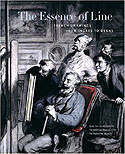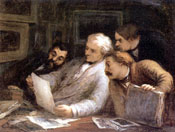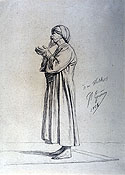The browser will either open the file, download it, or display a dialog.
|
The Essence of Line: French Drawings from Ingres to Degas |
|||||
| The Essence of Line: French Drawings from Ingres to Degas, the catalogue of an exhibition jointly organized by The Baltimore Museum of Art and The Walters Art Museum in 2005, provides a fascinating glimpse into the history of collecting in America. Though its focus is narrow—the collecting of French drawings in nineteenth-century Baltimore, its implications are broad. What the catalogue suggests, both through its essays and the works it features, is that collecting in America was determined not only by periodic fashions and by the preferences of individual collectors, but also by the unique social and economic circumstances that existed in specific urban centers. | ||||||
| In her introductory essay, "Mise en Scène," Cheryl Snay convincingly shows that the pronounced interest of Baltimorean collectors in French drawings may be related to strong ties that bound Baltimore to France. These ties were, in part, the result of the French Revolution. In 1791 several Sulpician priests left France for Baltimore and founded the first Roman-Catholic seminary in the United States. One of them, Ambrose Maréchal, became archbishop of Baltimore in 1817. Around the same time, a considerable number of French refugees came to the city from San Domingo (now Haiti), where a popular uprising had forced French aristocratic landowners and members of the island's colonial administration to flee. In Baltimore, they joined the French Acadians, who had come from Nova Scotia in 1756, causing the French population of Baltimore to rise to about one tenth of the total. Though many of the French emigrés eventually returned to their places of origin, they left a strong stamp on the city, where throughout the nineteenth century many educated people spoke French and looked to France as an example of fashionable living. | ||||||
| This "French Connection" may be seen as one of the causes of Baltimore's bustling art scene in the nineteenth century. It was manifest in the foundation of a number of cultural institutions and artistic associations, such as Rembrandt Peale's Museum and Gallery of the Fine Arts, the Baltimore Atheneum, the Peabody Institute, the Maryland Institute, the Maryland Academy of the Fine Arts, and the Charcoal Club. These brought together educated and well-to-do citizens interested in culture and the arts, who served as their founders, trustees, and members. It is among them that most of Baltimore's early collectors, men like Robert Gilmore and Charles James Madison Eaton, were found. | ||||||
| The fact that several of Baltimore's nineteenth-century collectors favored drawings is noteworthy. Snay suggests that the reasons for it were both theoretical and practical. Citing the emphasis that was placed on drawing education by such nineteenth-century theorists and artists as Charles Blanc and Maxime Lalanne in France, and Baltimorean Fielding Lucas, Jr. in the United States, she suggests that the collection of drawings was not merely a pastime of the rich, but that it had a "political dimension" related to the contemporary "efforts to reform education and society."1 While it is true that universal drawing education was perceived as a means of raising the level of the fine and industrial arts (which would benefit society as a whole), and was widely promoted on both sides of the ocean, I suggest that the fact that drawings were reasonably priced, easily transported, and required little storage space, may have been an equally important reason for collecting them. Many collectors, including the two major Baltimorean drawing collectors, George Lucas and William Walters, collected drawings to complement their collections of paintings and sculptures, the growth of which was limited by the amount of available wall and floor space in their homes. | ||||||
|
Snay does not deny that practical considerations, especially storage, played an important part in the collecting of drawings. Indeed, in a second catalogue essay, she reminds us of the way nineteenth-century drawing collections were kept and looked at by collectors. Drawings, she points out, were framed only when they were highly finished and colored. All others were placed in portfolios or albums, which could be perused at leisure by the collector and his friends. Honoré Daumier has left a series of memorable images in which collectors share the pleasure of their drawing and/or prints with friends (fig. 1). In all of these, the sheets are stored in simple cardboard portfolios and often appear to be un-mounted. | |||||
| American collectors seem to have preferred albums to portfolios. Albums were elaborately bound volumes of mounted drawings, sometimes framed by ink-drawn borders. The "tasteful" arrangement of drawings in such albums was an art in itself and, if well done, the album as a whole, as Snay suggests, would be greater than its parts. Few nineteenth-century drawing albums have been preserved in their original state. Nearly all were pulled apart once they were donated or bequeathed to museums, where modern museological practice dictated that drawings be un-mounted, matted, and stored in boxes. | ||||||
|
In the Walters Museum, exceptionally, thirteen of the original albums of collector William Walters (the father of the museum's founder, Henry Walters) are still extant, though many of the drawings were removed for the sake of preservation. A careful reconstruction of the albums by William R. Johnston (p. 33) shows that five of them contained drawings by American artists and four were devoted to French artists. Of these, one contained drawings by miscellaneous artists, two were devoted to the work of Paul Gavarni, and one to the drawings and watercolors of Léon Bonvin, an artist Walters had "discovered." One of the remaining four albums contained drawings by Belgian, Dutch, and German artists; the content of another is unknown. The last two albums are of particular interest for they contained drawings, both by French and non-French artists, that represented images of prayer in different cultures. Johnston surmises that the idea for these albums may have arisen after the death of Walters' wife, who was a devout Presbyterian. Walters commissioned many of these drawings from contemporary French artists, and apparently his interest the subject was so well known in France that in 1864 Jean-Léon Gérôme gave him a drawing after one of the figures in his Prayer on the Rooftops, now in the Hamburg Kunsthalle (fig. 2).2 | |||||
| While the extraordinary number of French drawings in nineteenth-century collections in Baltimore may be attributed, in general, to the city's historic ties with France, it was due, in particular, to the activities and interests of two men, George Lucas and William Walters, as Jay McKean Fisher and William R. Johnston clearly demonstrate in their two catalogue essays. The first was the son of Fielding Lucas, a successful publisher who played a major role in the foundation of several of Baltimore's cultural institutions, most notably the Maryland Institute. A dropout, like Whistler, from the West Point Military Academy, the younger Lucas moved to Paris in 1857 and never returned to the US. Thanks to his father's wealth, he was financially independent and became a collector of contemporary art. However, he supplemented his small capital by serving as an agent for American collectors and dealers, among them William Walters and John Stricker Jenkins in Baltimore, William Corcoran in Washington, and the collector/dealer Samuel P. Avery in New York.3 | ||||||
| Lucas's influence on American collecting of French art, especially in the 1850s and 1860s, cannot be overrated. Indeed, much French art that was acquired in America during these two decades bears the imprint of his taste. Lucas collected not only drawings but also paintings and small-scale sculptures. His main interest, however, was in nineteenth-century prints, of which he owned more than 18,000, a number that far exceeded the total of his drawings (347) and paintings (300). Lucas's preference was for the works of the Barbizon School and mid-nineteenth-century genre painters, such as François Bonvin, Edouard Frère, and Louis-Adolphe Hervier. He also fancied the work of Gavarni and the sculptor Antoine-Louis Barye. | ||||||
| It was Lucas who formed the taste of William Walters, a largely self-made man, who became one of the most important financiers in Baltimore after the Civil War. Walters began to collect in the early 1850s, buying mostly American paintings and drawings. By the late fifties, he expanded his collecting activity to French art and asked Lucas to become his agent. Walters's interest in French art began in earnest, however, during the Civil War when he moved to Paris with his family to avoid the armed conflict. In the French capital he met up with Lucas, who introduced him to numerous contemporary artists. Together, the two Americans traveled to the village of Ecouen, where a small artist's colony had formed around the successful genre painter Pierre-Edouard Frère, who had settled there in 1847. Walters took a fancy to the works of the Ecouen artists, who specialized in village genre scenes and bought numerous drawings from them, typically paying between 25 and 50 francs per sheet. Lucas also introduced Walters to Antoine-Louis Barye, who became one of the collector's favorite artists, as well as to Gavarni, François Bonvin and his brother Léon, and Félix Ziem, among others. Walters bought numerous works from all of them. | ||||||
| The collections of Lucas and William Walters are both now in Baltimore. Lucas bequeathed his collection to Henry Walters for transfer to the Maryland Institute, a training school for working class people that had been founded by his father, Fielding Lucas. In 1996, the collection was acquired by the Baltimore Museum and the Walters Art Museum with the help of a grant of the State of Maryland and private contributions. William Walters's collection became part of the museum that was founded by his son Henry, which opened in Baltimore in 1909. | ||||||
| Neither the catalogue nor the exhibition on which it was based accurately reflect(ed) the collecting patterns of these two most important nineteenth-century Baltimore drawing collectors, as the selection for the exhibition was adjusted to twenty-first century taste. Thus the drawings by such artists as Karl Bodmer, Louis-Adolphe Hervier, and Charles Jacque, which were collected in depth by Lucas, or those by artists like Léon Bonvin, Frère, Théophile Duverger, André-Henri Dargelas, Gavarni, and Paul Seignac, which were bought in quantity by Walters, are underplayed to feature drawings by such artists as Jean-Auguste Dominique Ingres, Edouard Manet and Edgar Degas that were acquired in the twentieth century.4 But for those who are interested in knowing the full extent of the holdings of nineteenth-century drawings in Baltimore collections, the organizers of the exhibition developed a wonderful website (http://www.frenchdrawings.org/index.php) that presents more than 900 drawings (as opposed to the 106 featured in the exhibition catalogue), complete with high-resolution images and full information about medium and provenance. It is a model site that provides a wealth of information to those interested in mid-nineteenth-century French drawings as well as in collecting patterns during the third quarter of the nineteenth century. | ||||||
| As valuable as the site is, however, it must be used in conjunction with the catalogue, which is important not only for its essays but also for its detailed and impeccably researched entries, which contain much new and valuable information.5 With its beautiful illustrations, its handsome design and layout, and its scholarly approach, this catalog and the website that accompanies it exemplify the wonderful things museums can do when focusing on their own collections. | ||||||
| Petra ten-Doesschate Chu Professor of Art History Seton Hall University |
||||||
|
2. For a reconstruction of these albums, see hyperlink http://www.frenchdrawings.org/sketchbooks.php. For more on this website, see the end of this essay. 3. The diaries of Lucas, which present a fascinating picture of his interaction with the art world of his time, were published by Lilian M.C. Randall in 1979 (Princeton University Press). 4. Either by collectors like the Cone sisters (Claribel and Etta), whose collection came to enrich the Baltimore Museum in 1950 or by museum curators. Jay McKean's Fisher's essay in the catalogue presents an overview of the Baltimore Museum's acquisitions of drawings in the twentieth century. 5. In my discussion of the essays, I did not mention the valuable one by Kimberley Schenck on nineteenth-century drawing materials. |




